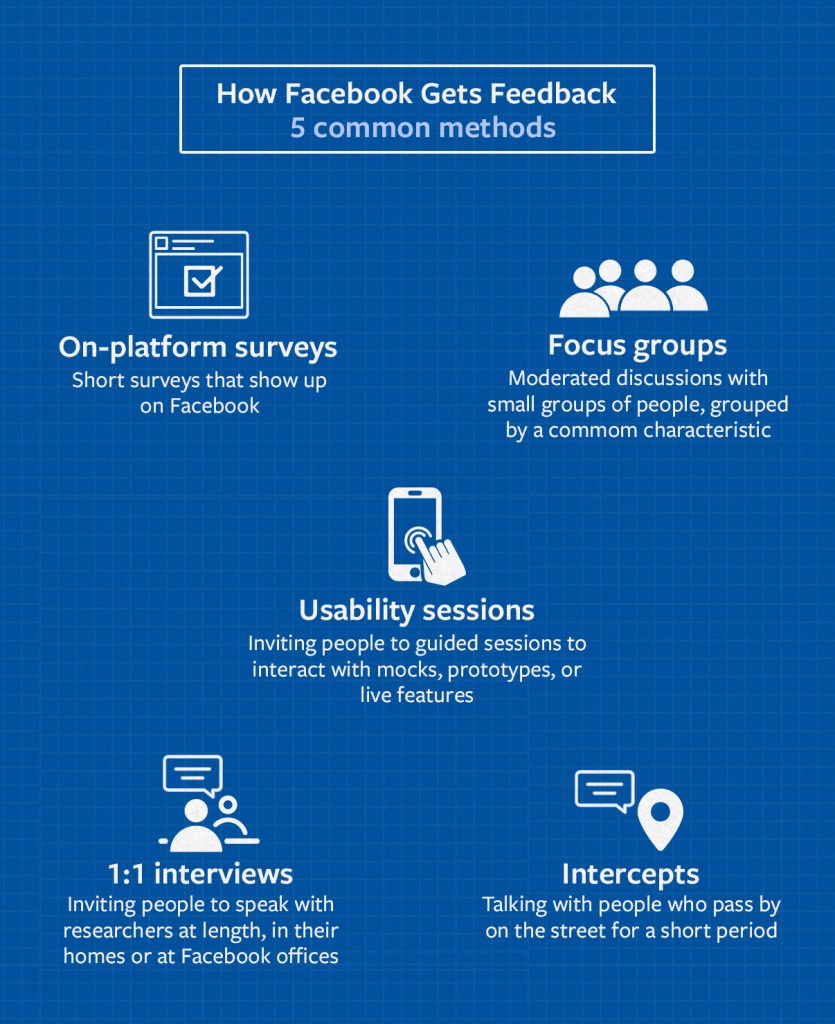It seems like every Facebook product announcement calls out something that was “heard from people” as the motivation for creating the feature. How exactly does Facebook collect and process all that feedback?
To find out, we sat down with the people who lead that work: the user research team.
“A lot of what user research is trying to do is help the product designers and engineers really understand who they’re building for and what their needs and wants are,” says David Ginsberg. Ginsberg oversees a team of more than 100 researchers that focus on the Facebook app, from News Feed to profiles to the search experience.
Many tech companies rely on a range of research methods to learn more about what people want and need from their products, and Facebook is no exception. Some of the methods Ginsberg’s team uses involve talking to small groups of people and are exploratory in nature: Researchers might invite people to sit down for one-on-one interviews, join focus groups or keep diaries about their experiences with the app over time. On the other end of the spectrum, researchers invite large groups of people to take surveys, often via the Facebook app itself — tens of thousands of people opt into taking surveys every week. Using a mix of these methods, product teams can learn a lot about what users care about and why. The more intimate, qualitative methods yield rich, resonant anecdotes that help illustrate the nuances and complexities of people’s feelings about an issue, while broader-reaching quantitative methods, like surveys, help define how particular groups of people feel about different issues and how many people share those attitudes.
And with more than 2 billion people using Facebook every month, researchers have to carefully construct their study designs to make sure that they’re hearing from representative swathes of the community, all over the world.

User feedback informs all phases of product development. For example, in January, Facebook announced that it would begin to adjust ranking to make News Feed more about supporting more meaningful social interactions on Facebook. That shift was sparked by a number of inputs, from academic research to responses to surveys, run by the News Feed research team, which showed people wanted to see more posts from their friends and family. Since the initial shift in January, the research team has continued to reach out to people through surveys, interviews and diary studies to deepen their understanding of what people consider to be “meaningful” interactions with others. Recently, the team has been looking to understand what types of interactions (likes, comments, re-shares, etc.) are most meaningful to people — and whether it matters how close someone is to the person they’re interacting with. Those learnings go on to influence ongoing updates to ranking, as well as other products.
Soliciting feedback from users is actually just one way Facebook brings outside voices into the mix. Researchers as well as Facebook’s partnerships and policy teams regularly talk with experts in civil society, the academy and elsewhere to ensure they’re up-to-date on the latest research and best practices.
What people do on the platform is an important, implicit form of feedback that product teams take into account as well. For example, in the early days of Facebook, the only type of photo you could upload was your profile photo. But then the company noticed an intriguing trend: people were constantly switching their profile photos, sometimes as often as once an hour. They realized that people were trying to share more visual moments from their lives and so in 2005, Facebook launched the ability to upload photos, arrange them in albums and tag people. Facebook later became the most popular photo-sharing service in the world. Looking at what people aren’t doing on the platform is a helpful insight, as well: Earlier this year, Facebook removed the Trending news feature because it was getting so little usage. (This is why it’s helpful that Ginsberg and his researchers work closely with the analytics team that analyzes on-platform trends.)
With so many different types of feedback coming in, a big part of the research team’s work is understanding how all of those things come together, to best understand what the community is asking for. Lauren Scissors, who leads News Feed research, says that for years, people kept asking Facebook to build a “dislike” button. But when her team dug a little deeper, through interviews and surveys, the “latent desire” they heard from people was that they didn’t feel that the Like button captured the entire range of emotions they wanted to express. That insight led to the 2016 launch of five new Reactions, adding “Love,” “Haha,” “Wow,” “Sad” and “Angry” to the classic thumbs-up “Like.”
Ultimately, the desire to express the full range of one’s emotions is a prime example of a “people problem” — a guiding concept that helps make sure teams are building something people will actually use, instead of just something the company wants people to use. “A lot of the things we’re building on Facebook are new ways to help people do things that they have been doing for years — staying connected, sharing about their lives, learning about the world,” Scissors explains. “If we only think about people’s motivations and desires through the lens of Facebook, we’re probably going to miss the deeper or even new ways we can help people connect, share, and learn.”
See also:
How People Help Fight False News
Hard Questions: Is Spending Time on Social Media Bad for Us?
Facebook Recently Announced a Major Update to News Feed; Here’s What’s Changing


